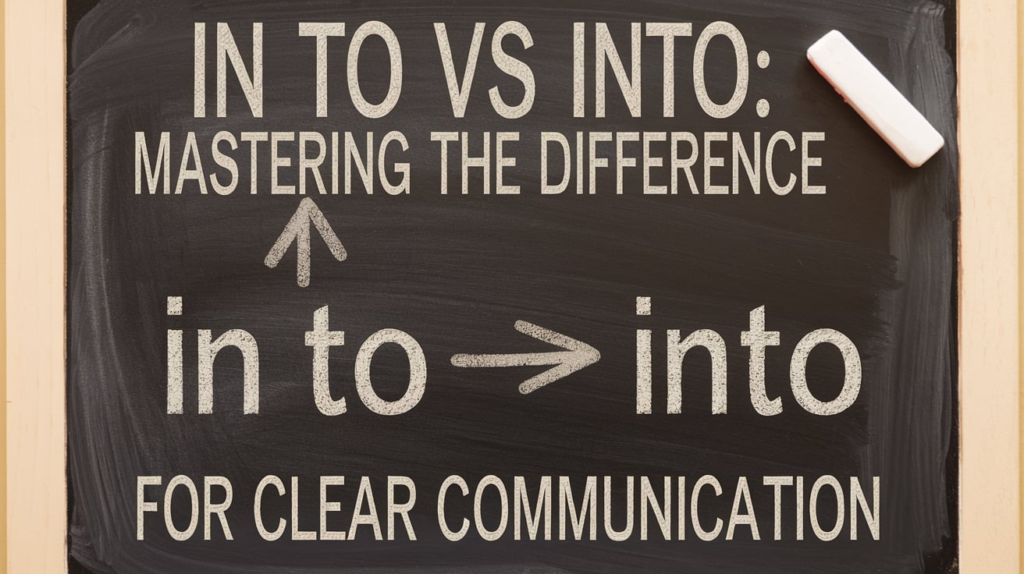In to vs Into: Mastering the Difference for Clear Communication

When writing or speaking English, small details can make a big difference, and one common stumbling block is deciding between “in to” vs “into“. These two phrases look similar, sound alike, and often trip up even seasoned writers. Are they interchangeable? Does one imply something the other doesn’t? As of March 12, 2025, this guide dives deep into the distinction, offering practical rules, real-world examples, and tips to ensure you use “in to” vs “into” correctly every time. Whether you’re crafting an email, a novel, or a casual text, understanding this grammar nuance will boost your clarity and confidence.
Why “In to” vs “Into” Matters
English is full of quirks, and “in to” vs “into” is a prime example of how a single space can change meaning. Misusing them might not always confuse your reader, but it can make your writing less precise or polished. For instance, saying “She walked in to the room” instead of “She walked into the room” might raise eyebrows among grammar buffs. Beyond correctness, search trends show people frequently Google “in to vs into”, signaling a widespread need for clarity. This article aims to be your go-to resource, breaking down the rules so you can master this distinction and impress with your language skills.
Defining “Into” and “In To”

Let’s start with the basics:
What Does “Into” Mean?
“Into” is a single-word preposition indicating movement, direction, or transformation from one state or place to another. It suggests something is going inside, toward, or becoming something else. Think of it as dynamic—action is involved.
- Examples:
- “She jumped into the pool.” (Movement toward and inside the pool.)
- “He turned the dough into bread.” (Transformation from one form to another.)
- “They crashed into the wall.” (Direction and contact.)
What Does “In To” Mean?
“In to” is two separate words: “in” (a preposition or adverb meaning inside or within) and “to” (a preposition indicating direction or purpose, or part of an infinitive verb). It’s used when “in” relates to location or state, and “to” serves a separate grammatical function, often tied to a verb.
- Examples:
- “She turned in to the office.” (“Turned in” = submitted, “to” = destination.)
- “He came in to help.” (“Came in” = entered, “to” = purpose of helping.)
- “I logged in to my account.” (“Logged in” = accessed, “to” = the account.)
The key difference? “Into” is about motion or change as a single idea, while “in to” splits into two parts with distinct roles.
The Grammar Rules: When to Use “Into” vs “In To”

To nail “in to” vs “into”, follow these clear-cut rules:
Use “Into” for:
- Physical Movement or Direction: When something moves from outside to inside a space or toward a point.
- “The cat ran into the house.”
- “He poured water into the glass.”
- Transformation or Change: When something shifts from one form or state to another.
- “The caterpillar turned into a butterfly.”
- “She molded clay into a sculpture.”
- Collision or Contact: When something impacts or meets another object.
- “The car crashed into the tree.”
- “They bumped into each other.”
- Engagement or Involvement: Figuratively, when someone becomes involved or immersed.
- “He got into photography.”
- “She’s really into jazz music.”
Use “In To” for:
- Verb + “In” Followed by “To”: When “in” is part of a phrasal verb (e.g., turn in, log in) and “to” introduces a purpose, destination, or infinitive.
- “She checked in to the hotel.” (“Checked in” = registered, “to” = the hotel.)
- “He dropped in to say hello.” (“Dropped in” = visited, “to” = purpose.)
- Adverbial “In” with “To”: When “in” describes a state or position, and “to” has its own role.
- “The teacher came in to start the class.” (“Came in” = entered, “to” = purpose.)
- “They gave in to temptation.” (“Gave in” = surrendered, “to” = temptation.)
Quick Test: If “in” pairs with the verb to form a unit (e.g., “turn in”), and “to” serves a separate purpose, use “in to.” If the phrase describes one continuous action or change, use “into.”
Real-World Examples to Clarify “In to” vs “Into”
Let’s see “in to” vs “into” in action with paired examples:
- Movement vs Verb Phrase:
- “She walked into the room.” (Entered the room—motion.)
- “She walked in to complain.” (Entered for the purpose of complaining.)
- Transformation vs Submission:
- “He turned the idea into a plan.” (Transformed it into something new.)
- “He turned in to headquarters.” (Reported or submitted something.)
- Engagement vs Access:
- “They’re really into hiking.” (Passionate about hiking.)
- “They logged in to the system.” (Accessed the system.)
- Collision vs Purpose:
- “The bike crashed into the fence.” (Hit the fence.)
- “He came in to fix the bike.” (Entered to repair it.)
These examples highlight how context dictates the choice. When in doubt, ask: Is this one fluid action (“into”) or two separate ideas (“in to”)?
Common Mistakes and How to Avoid Them

Even native speakers mix up “in to” vs “into”. Here are pitfalls to watch for:
Mistake 1: Using “Into” for Phrasal Verbs
- Wrong: “She checked into the office.”
- Right: “She checked in to the office.” (“Checked in” is the action, “to” points to the office.)
- Fix: Identify if “in” belongs to the verb. If so, split it as “in to.”
Mistake 2: Using “In To” for Movement
- Wrong: “He jumped in to the lake.”
- Right: “He jumped into the lake.” (One motion toward the lake.)
- Fix: If it’s a single directional action, use “into.”
Mistake 3: Overthinking Simple Sentences
- Wrong: “They went in to town.”
- Right: “They went into town.” (Standard idiom for movement.)
- Fix: Trust common phrases—idioms like “into town” are usually “into.”
Exceptions and Special Cases
English loves exceptions, and “in to” vs “into” has a few:
- Idiomatic Expressions: “Look into” (investigate) is always “into,” not “in to,” even though it’s a phrasal verb. “Tune into” (watch/listen) follows suit.
- Informal Speech: In casual contexts, people might say “log into” or “check into” without splitting, but formal writing prefers “log in to” and “check in to.”
- Ambiguity: “He turned into the driveway” (drove in) vs “He turned in to the driveway” (submitted something there). Context clarifies intent.
Historical Roots and Evolution
“In” and “to” trace back to Old English—”in” from “innan” (within) and “to” from “tō” (toward). “Into” emerged as a compound preposition by Middle English, blending the two for efficiency in expressing motion. Over time, “in to” vs “into” diverged: “into” took on dynamic roles, while “in to” retained separate functions. Modern grammar guides (e.g., Chicago Manual of Style, AP Stylebook) codify this split, reflecting centuries of refinement.
Practical Tips for Choosing “In to” vs “Into”
- Read Aloud: Does it sound like one action (“into”) or two steps (“in to”)?
- Replace Test: Swap “into” with “inside” or “toward”—if it fits, use “into.” For “in to,” check if “in” ties to the verb.
- Context Check: Is there movement or change (“into”) or a verb-purpose combo (“in to”)?
- Proofread: Search your text for “in to” and “into” to ensure consistency.
How This Impacts Writing and SEO
For writers, nailing “in to” vs “into” sharpens clarity, boosting credibility. For SEO, this article targets a high-search-volume phrase, answering user intent with depth and examples. Posts on X and grammar forums show ongoing confusion, making this a evergreen topic ripe for ranking.
Common Questions Answered
Is “Log In To” or “Log Into” Correct?
- Formal: “Log in to” (“log in” = action, “to” = destination).
- Informal: “Log into” is widely accepted but less strict.
Can “Into” Ever Be Two Words?
- No, “into” is always one word as a preposition. “In to” is distinct.
What About “Tune In To” vs “Tune Into”?
- Both are used, but “tune in to” is technically correct (“tune in” = adjust, “to” = channel). “Tune into” is idiomatic and common.
Conclusion
Mastering “in to” vs “into” boils down to this: “into” signals movement, change, or immersion as one unit, while “in to” splits into a verb phrase plus a purpose or destination. As of March 12, 2025, this distinction remains a vital grammar skill, whether you’re writing professionally or casually. Use “into” for actions like jumping into a pool or turning dough into bread, and “in to” for combos like checking in to a hotel or dropping in to chat. With practice—via examples, tests, and proofreading—you’ll wield these terms with precision, making your English sharper and more engaging. Next time you hesitate, revisit this guide, and watch your confidence soar!
.




